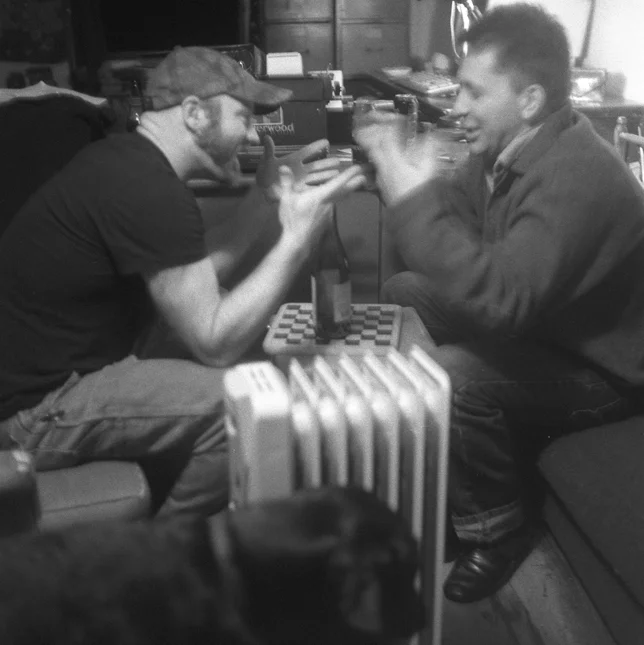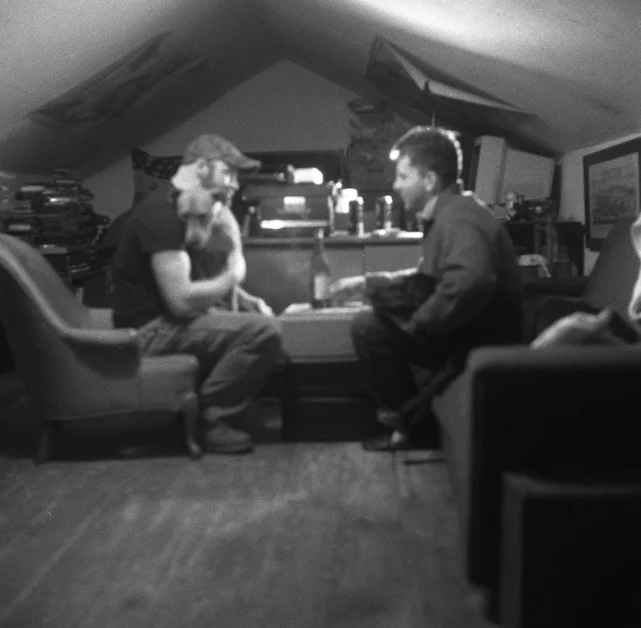Drinking with Jake (Round Zero) – Jason Kelley
Written by Jake Shivery
What follows is a reprint from 2011’s Diffusion III – a precursor to “Drinking with Jake”.
We reproduce it here in anticipation of Jason’s solo exhibition at Good Gallery, which opens on Friday, July 6th, 2012.
Photo by Oliver Ogden
Jason Kelley and Jake Shivery have been best pals for damn near a decade. They have spent most of that time talking, at length, about photography. For the purposes of this interview, they settled in to comfortable surroundings with their dogs and plenty of whiskey and then set about trying to describe Jason’s relationship with strip photography in fifteen hundred words or less.
Who: Mr. Jason E. Kelley, Linear Strip Photographer
Where: Jake’s attic
When: March, 2011
What: Corner Creek out of the bottle
Jake: So, why use strip photography over a more “traditional” form of photography?
Jason: With traditional photography, the focus is on the still image. Photographers go to great lengths to set up a still image. But with strip photography, the emphasis is on what’s moving. And what can be done with what’s moving.
JS: There certainly is a lot of movement. And I’m seeing things I’ve never seen before. I’ve never seen a centurion battling a druid at Stonehenge, for instance.
JK: With that particular image, I was trying to illustrate a warp in time. I’m not sure I would’ve felt comfortable trying to illustrate that concept without a sense of movement.
JS: We’ve all been watching for the last couple of years and observing your slow slide over towards a more and more narrative form. Care to speak about the importance of narrative form in strip photography?
JK: In the past, the narratives that I’ve seen in my head, I’ve never been able to handle them properly as a still image. But strip photography imbues the image with a kinetic energy, a sense of movement – something is happening. This is important for the ideas in my head because everything needs to be moving around. It doesn’t make sense otherwise, to me anyway.
JS: In the past, you’ve worked with other forms: mirror lenses, pinhole, and some of my personal favorite work, the photo booth project.
JK: And the photo booth was, or is, fun, but it’s just that – it’s my fun photography. It gives me something to do at parties. I enjoy doing it, but I feel like I’ve hit the ceiling with it, creatively speaking. Photo Booth was the only time I wasn’t actively trying to distort reality, and I knew I had to get back to that – from the first time I picked up a camera, I was working on distortion – with different lenses, focus shifts, focal length, and now with moving film. Even though it feels like I have a long way to go, and I’ll probably always have a long way to go, strip photography has finally afforded me that proper distortional balance for the ideas in my head, yet still leaving me plenty of room for evolution. Basically, the form resonates better with what I have to say. At the same time, the narratives and my thought processes have been heavily influenced by what strip photography does to the image. I’m going to guess it’s like that with every art form, the medium will always influence the direction of the work, while still being complementary to your personal artistic process.
JS: Let’s use that segue to talk about process. We’re lashing together this interview so that there will be some context for folks looking at the images in Diffusion Three. How important do you think this is, and are you happy with the idea of the interview? Would you prefer that people have the paragraph next to the photo, or that they just saw it cold and had to wonder? Would you prefer that the audience wasn’t actually reading this interview?
JK: I definitely don’t want a paragraph next to each image explaining what’s happening. But, I think that with the more labor-intensive processes, it’s important for the viewer to have access to an explanation of what’s going on. Certain people will be thinking: “Oh, this isn’t just a still image – this is something else – what’s going on here? I have to know.” It’s only fair that their curiosity be sated.
JS: Well, we’ve spoken a lot in the past about how art, specifically photography, should always be able to stand on its own. That if a photo needs even a caption then it’s intrinsically missing something as a piece.
JK: I know. And the need for explanation with strip photography is almost painfully required. How do I explain this effectively? When I see a photo on a wall, I want to have a reaction, I want to sense the beauty in the piece and have an emotional reaction – I want to be moved. And I think strip photography does that, or at least the successful images do. But then there are other people, the curious people. They want to know, and you have to tell them.
JS: And to make any sense out of it, you have to be a photographer?
JK: Well, yes and no. Lori [Jason’s fiancé] is certainly interested in the process. I mean, she’s certainly interested in the human element and the narrative as well, but even though she’s not a photographer, she’s still interested in the technical applications.
JS: So let’s talk about tech. I love telling the story of you and strip photography, and your process. You’re out there in the field with your sundial and your abacus and your yardstick. You shoot with a modified Canon AE1 with a giant manual crank and you’re doing all this with your head and with your hands. I’m quite sure that when most people look at this work, they assume you’re using a computer. That, if anything, you just went crazy with Photoshop.
JK: But I do use a computer. I mean, ultimately, I have to put them through the computer to be able to pull the kind of prints that I want. But all of the manipulation and distortion is done in the camera. I’ve always preferred to work on the front end – the computer is just a vehicle for getting to the prints.
JS: I still think it’s important to point out that you could do all this without a computer.
JK: Oh sure, all you really need is an opaque piece of material with a slit and a way to move the film. And some ideas that want to move.
JS: Let’s talk a bit about the camera that you’re using and the modification.
JK: The modification is simple. To do what I’m doing, you take a 35mm camera, and you put an opaque screen between the lens and the film. And in that opaque screen, you put a 1mm slit up the vertical length. This allows 1mm of light to strike the film as it passes by. You just open the shutter and start moving the film past the slit. I’m using a hand crank from a Beseler enlarger to transport the film. Other strip photographers have motor drives to move the film, which does provide smoother and cleaner images, but isn’t necessary.
JS: And this is what makes everything look like a comic book?
JK: True. At it’s most basic, anything that is moving in pace with the film becomes the “static” subject, and anything not moving blurs and streaks and becomes the background. There are subtleties here, of course. And it’s the exploration of those subtleties that’s most interesting.
JS: Lastly, let’s talk about your short term and long term goals with strip photography.
JK: In the short term, I need to keep perfecting my control. As well as play more with depth in the image. Also, start shaking things up a bit more – some macro, more elaborate costuming and props, panning, and precise control of lighting. But ultimately, I’m most interested in using the power of the motion blur and then compounding the effects. In the more long term sense, I’m interested in fully exploring the narrative, and specifically with the synthesis between science concepts and art. People seem to think of science and art as opposites, or at least irreconcilable. I think this can’t be farther from the truth. I think science and art are twins. Born of the same parents with different life aspirations perhaps, but nevertheless, family. Science and art are from the same gene pool.






